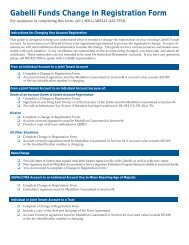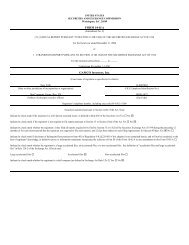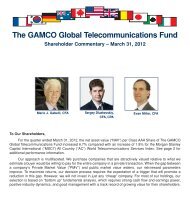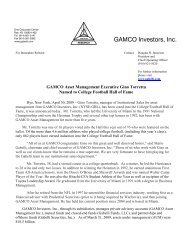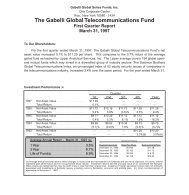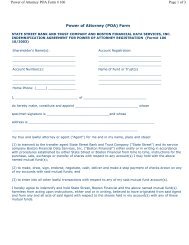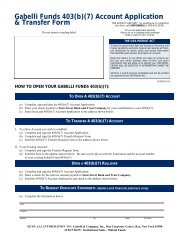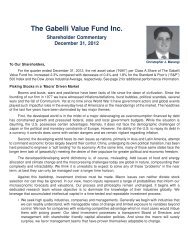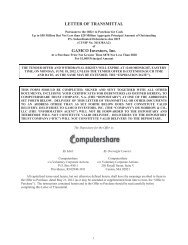Statement of Additional Info - Gabelli
Statement of Additional Info - Gabelli
Statement of Additional Info - Gabelli
Create successful ePaper yourself
Turn your PDF publications into a flip-book with our unique Google optimized e-Paper software.
during the option period, and (c) out-<strong>of</strong>-the-money call options when the Adviser expects that the premiums received<br />
from writing the call option plus the appreciation in market price <strong>of</strong> the underlying security up to the exercise price will<br />
be greater than the appreciation in the price <strong>of</strong> the underlying security alone. In these circumstances, if the market price<br />
<strong>of</strong> the underlying security declines and the security is sold at this lower price, the amount <strong>of</strong> any realized loss will be<br />
<strong>of</strong>fset wholly or in part by the premium received. Out-<strong>of</strong>-the-money, at-the-money, and in-the-money put options (the<br />
reverse <strong>of</strong> call options as to the relation <strong>of</strong> exercise price to market price) may be utilized in the same market<br />
environments that such call options are used in equivalent transactions.<br />
So long as a Fund's obligation as the writer <strong>of</strong> an option continues, the Fund may be assigned an exercise notice by the<br />
broker-dealer through which the option was sold, requiring the Fund to deliver, in the case <strong>of</strong> a call, the underlying<br />
security against payment <strong>of</strong> the exercise price. This obligation terminates when the option expires or the Fund effects a<br />
closing purchase transaction. A Fund can no longer effect a closing purchase transaction with respect to an option once it<br />
has been assigned an exercise notice. To secure its obligation to deliver the underlying security when it writes a call<br />
option, or to pay for the underlying security when it writes a put option, a Fund will be required to deposit in escrow the<br />
underlying security or other assets in accordance with the rules <strong>of</strong> the Options Clearing Corporation (the "Clearing<br />
Corporation") and <strong>of</strong> the national securities exchange on which the option is written.<br />
An options position may be closed out only where there exists a secondary market for an option <strong>of</strong> the same series on a<br />
recognized national securities exchange or in the over-the-counter market. As a result, and because <strong>of</strong> current trading<br />
conditions, the Funds expect to purchase only call or put options issued by the Clearing Corporation. The Funds expect<br />
to write options on national securities exchanges and in the over-the-counter market.<br />
While it may choose to do otherwise, a Fund generally purchases or writes only those options for which the Adviser<br />
believes there is an active secondary market so as to facilitate closing transactions. There is no assurance that sufficient<br />
trading interest to create a liquid secondary market on a securities exchange will exist for any particular option or at any<br />
particular time, and for some options no such secondary market may exist. A liquid secondary market in an option may<br />
cease to exist for a variety <strong>of</strong> reasons. In the past, for example, higher than anticipated trading activity or order flow, or<br />
other unforeseen events, at times have rendered certain <strong>of</strong> the facilities <strong>of</strong> the Clearing Corporation and the national<br />
securities exchanges inadequate and resulted in the institution <strong>of</strong> special procedures, such as trading rotations, restrictions<br />
on certain types <strong>of</strong> orders or trading halts, or suspensions in one or more options. There can be no assurance that similar<br />
events, or events that may otherwise interfere with the timely execution <strong>of</strong> customers' orders, will not recur. In such<br />
event, it might not be possible to effect closing transactions in particular options. If as a covered call option writer a<br />
Fund is unable to effect a closing purchase transaction in a secondary market, it will not be able to sell the underlying<br />
security until the option expires or it delivers the underlying security upon exercise.<br />
A covered call option written by a Fund, which is a call option with respect to which the Fund owns the underlying<br />
security, exposes the Fund during the term <strong>of</strong> the option to possible loss <strong>of</strong> opportunity to realize appreciation in the<br />
market price <strong>of</strong> the underlying security or to possible continued holding <strong>of</strong> a security which might otherwise have been<br />
sold to protect against depreciation in the market price <strong>of</strong> the security. A covered put option sold by a Fund exposes the<br />
Fund during the term <strong>of</strong> the option to a decline in price <strong>of</strong> the underlying security. A put option sold by a Fund is<br />
covered when, among other things, cash, cash equivalents, or U.S. government securities or other liquid debt securities<br />
are placed in a segregated account to fulfill the obligation undertaken.<br />
A Fund treats options in respect <strong>of</strong> specific securities that are not traded on a national securities exchange, and the<br />
underlying security, as not readily marketable and, therefore, subject to the limitations under "Certain Fundamental<br />
Policies" below.<br />
Stock Index Options (the Mighty Mites Fund, the SmallCap Equity Fund, the Mid-Cap Equity Fund, the Income<br />
Fund, the Equity Fund, and the Balanced Fund). These Funds may purchase and write put and call options on stock<br />
indices listed on national securities exchanges in order to realize their investment objectives or for the purpose <strong>of</strong> hedging<br />
their portfolio. Should a Fund seek to engage in transactions concerning put and call options on stock indices, options<br />
would be purchased or written with respect to not more than 25% <strong>of</strong> the value <strong>of</strong> the Fund's net assets. A stock index<br />
fluctuates with changes in the market values <strong>of</strong> the stocks included in the index. Some stock index options are based on a<br />
broad market index such as the New York Stock Exchange (“NYSE”) Composite Index, or a narrower market index such<br />
as the Standard & Poor's 100 Stock Index. Indices may also be based on an industry or market segment such as the<br />
American Stock Exchange Oil and Gas Index or the Computer and Business Equipment Index.<br />
11



